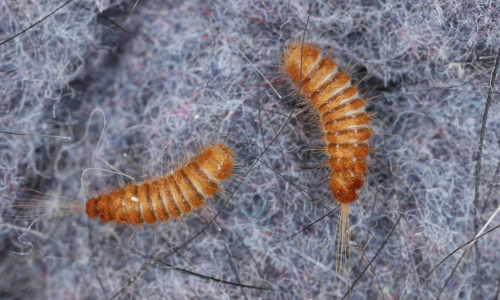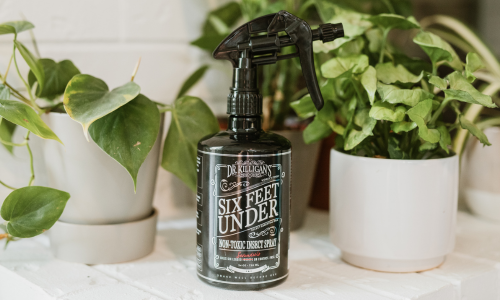Brown earth, three copper pennies, and a rabbit’s foot fell to the ground. I watched as the earth, thin and old, carried itself and settled on my open books, my index cards—with their chicken-scratch notes—and the rim of that black cup of long-forgotten coffee. I didn’t heed the dull coins. My eyes, tracing the patterns of dust as the fine particles made their way to the ground, took notice of the rabbit's foot. It had been a gift from my father when I was a small child. It must have been left in these jeans, jeans that I hadn’t worn in ages, jeans that had been tucked away and forgotten about so many years ago—jeans that held memories.
The rabbit’s foot looked old and weary, its edges of the once-white hair marred, having been eaten by clothing moths. Or maybe it had been carpet beetles. As I brought the rabbit’s foot close to my eyes, I examined it closely, thinking of how memories can be lost or stolen by nature and the hunger of bugs, thinking of how treasures and keepsakes and beauty can be ruined because they weren’t properly cared for. They were left in someone’s pocket, a grandmother’s attic, an uncle’s basement, or a box marked "Keep" in your own garage. And then never the same.
My mission today is to help you protect these memories, these treasures—in this case, to give you a better understanding of those insects that can and will eat your lucky rabbit’s foot. Carpet beetles.
What are carpet beetles?

Carpet beetles were named when most carpets were made of wool. With their rounded bodies and short antennae, they resemble a smaller, different-colored version of ladybugs. Their bodies have a striped shell of black, white, yellow, or orange. In terms of size, they measure 1/16 to 1/8 of an inch, which is roughly the same size as bed bugs. Because of this, they can often be mistaken for bed bugs. It’s important to note, though, that carpet beetles do not bite, as they do not need a "blood meal" to survive.
Carpet beetle larvae are even smaller, about 1/8-inch to 1/4-inch long. They are tan to brown in color, slow moving, and, as they are covered with hairs or bristles, are known as "wooly bears." Their shed skins and fecal pellets, about the size of a grain of salt, are clear evidence of their presence.
What are the most common types of carpet beetles?
There are several types of carpet beetles that you may find in your home, all of which can cause serious damage. Here are the three most common:
- Varied carpet beetles: They are black with white, brown, and yellow scales.
- Black carpet beetles: They are black with no scales.
- Furniture carpet beetles: They are black with white, brown, yellow, and orange scale.
Where do carpet beetles come from?
Unlike Asian ladybugs, carpet beetles aren’t typically looking to nest in your home, though they can be found there. These are the three most common reasons that cause their presence in your home:
- They unintentionally fly into your home while moving from flower to flower looking for nectar.
- They fly or crawl through gaps in window and door frames as they are attracted to the light inside of your home.
- They are accidentally brought inside on items such as cut flowers.
Once inside, they will actively seek out food sources in dark, sheltered areas to both feed and lay eggs.
What do carpet beetles eat?

Adult carpet beetles eat pollen, nectar, potpourri, and flower arrangements. They cause no damage to fabrics. They are generally found outdoors, feeding on the flowers of crape myrtle, spiraea, buckwheat, and other plants that produce abundant pollen.
It’s their children—the larvae—that are of concern, as they feed on materials containing keratin, a fibrous consumable (at least for carpet beetles and clothing moths) protein component of feathers, hair, fur, horns, antlers, hooves, nails, and beaks. Carpet beetle larvae will veer clear from cotton and synthetic fibers such as polyester and rayon, unless these fabrics are blended with wool or heavily soiled with food stains or body oils. These are the same foods that clothing moths feed on.
Items that carpet beetles will commonly eat and damage are:
- Wool
- Felt, (including the felt in pianos)
- Fur
- Silk
- Feathers, (including any feathers in furniture, mattresses, and pillows)
- Leather
- Human hair
- Carpet fibers
- Preserved or taxidermic specimens
- Animal fur
- Animal hides, horns, and antlers
- Dog food
- Spices
- Plant-based materials including seeds, cereals, and pet food
- Dead insects, bird nests, and animal carcasses
What is the difference between carpet beetles and clothing moths?
As adults, carpet beetles and clothing moths are easy to tell apart: While a carpet beetle is dark-colored, oval-shaped beetle that runs around on its six legs, the clothing moth is a beige-colored elongated moth that flutters to and fro. If you uncover an infestation, though, it can be more difficult to tell the larvae apart—unless you know what you’re looking for.

- Larvae feeding habits: Clothing moth larvae (unlike carpet beetle larvae) prefer to feed on items contaminated with organic materials such as spilled food, body fluids, fungal spores, or pollen.
- Larvae feeding damage: Clothing moth larvae tend to create scattered holes in a garment, whereas carpet beetle larvae are more likely to damage a large area or portion of a garment.
- Larvae color: Clothing moth larvae are cream-colored, whereas carpet beetle larvae are brown to tan in color.
- Larvae hair: Clothing moth larvae look like wiggling hairless grains of rice (with dark heads), whereas carpet beetles, commonly oval-shaped, look like fuzzy worms. They are densely covered with hair or bristles.
- Larvae stripes: Clothing moth larvae have no stripes, whereas carpet beetles have white and tan stripes along their backs.
- Larvae length: Clothing moth larvae are approximately ½ inch long, whereas carpet beetle larvae are approximately ⅛ to ¼ inch long.
- Larvae webbing: Clothing moth larvae will create webbing along the corners of packages or on the product inside, whereas carpet beetles do not create any webbing.
- Larvae molting: Clothing moth larvae do not leave noticeable shed skins, whereas carpet beetle larvae leave behind brown, shell-like, bristly-looking cast skins as they molt.
Within your home, a common sign of a carpet beetle infestation is seeing their (adult) presence on your windowsills in the spring. Clothing moths, on the other hand, will always hide. They are shy and prefer the dark.
How do I get rid of these pests?
If you are seeing holes in your sweaters, but can’t find the culprit that is ruining your clothing, there is an easy solution. Use my Premium Clothing Moth Traps. By placing these traps in your closet, you’ll be sure to catch those keratin-eating beasts. That’s the easy part.
To get rid of carpet beetles—whether they be the black, varied, or furniture species—you’ll need to roll up your sleeves, arm yourself with Six Feet Under, and get to work. Actually, if you have clothing moths, you’ll need to do the same amount of work, as now you’re going after the larvae.
In addition to inspecting the list of bulleted items above, investigate these locations:
- Closet and dresser drawers: When inspecting clothing items, pay special attention to the item’s seams, folds, and creases, (such as cuffs and collars), as this is where larvae often prefer to feed.
- Rugs and carpeting: When inspecting wool floor coverings, consider lifting the outer edges of wall-to-wall carpeting from the tack stripes along the baseboards.
- Upholstered furniture: When inspecting furniture that is padded or made from natural fibers, such as horse hair, carefully check the edges.
- Floor vents and ducts: When inspecting, look for an accumulation of pet hair or lint.
Carpet beetles, like clothing moths, prefer to dwell in dark, undisturbed areas where keratin-rich items have long been stored. Once discovered, treatment includes:

- Bagging and disposing of heavily infested items. Dry-clean or hot launder clothing items you keep.
- Vacuuming floors, carpets, and inside heating vents, making sure to get beneath edges of rugs, along baseboards, underneath furniture, along floor/wall junctions, and inside closets. Use the vacuum's small attachments to do a thorough job.
- Applying Six Feet Under, a non-toxic spray that will ensure that any remaining eggs are killed, to any areas where there has been adult beetle or juvenile beetle (larvae) activity. This includes:
- Infested rugs and carpets. (Before applying to fabrics, first test an inconspicuous spot)
- Edges of floor coverings
- Beneath furniture
- On the floors and walls of closets
- On shelving where susceptible fabrics are stored
- In cracks and crevice
- In areas where lint and hair may have accumulated
Final word on what’s eating your wool
I wasn’t able to save my childhood charm before it fell victim to carpet beetles. I didn’t have a thorough understanding of insects back then. I hope that, girded with this knowledge, you’re able to keep your childhood treasures from being destroyed.
As always, your thoughts, questions, and feedback are welcome. Simply post a comment.










